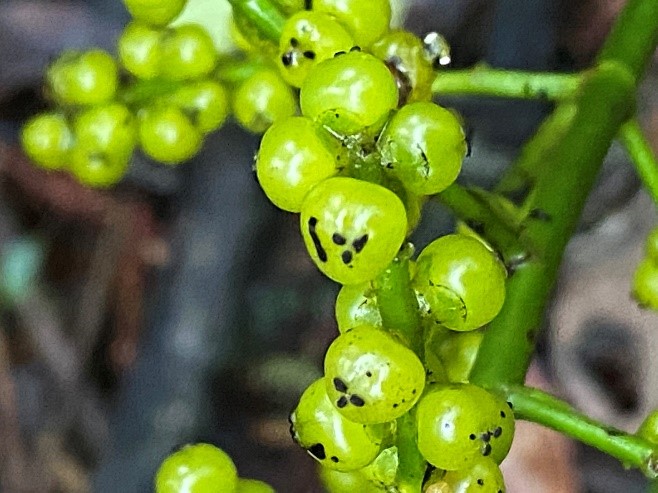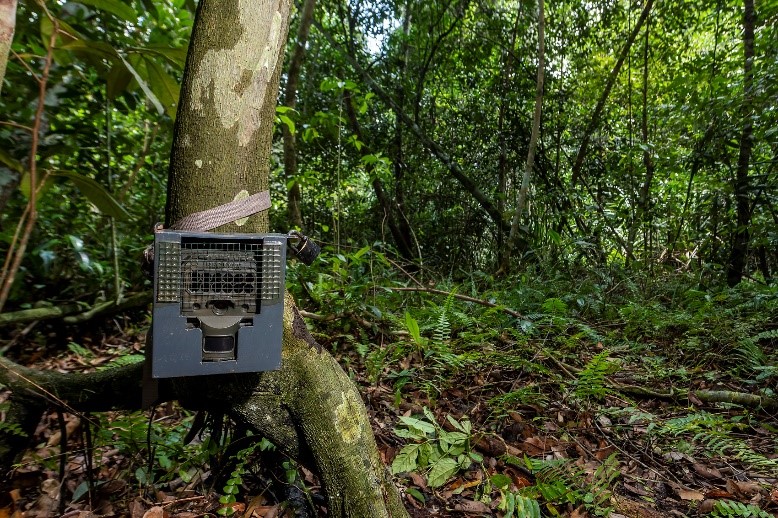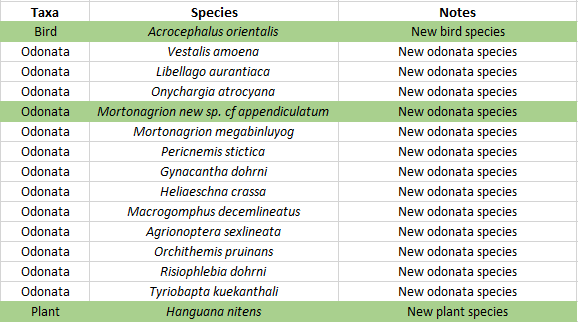October 03, 2023
Restorasi Ekosistem Riau (RER) is an incredibly biodiverse landscape, home to a wide variety of animals and plants. An essential part of the RER restoration project is the continuous surveys and monitoring for potentially new species. Using camera traps, transects, and visual surveys, our team goes out into the field each year to study and document the wildlife of RER, providing new insights into the many residents of the RER ecosystem.
Also read: Camera Traps – Everything You Need to Know
In 2022, these surveys reported a total of 846 species living in RER. This included 78 mammals, 106 amphibians and reptiles, 317 birds, 198 plants, 89 fish, and 58 Odonata (an order of flying insects that includes dragonflies and damselflies). During the first half of 2023, a further 15 species have been discovered – a clear reflection of RER’s species diversity potential.
“Adding new species to RER’s growing taxonomic records are always a delight,” explains Prayitno Goenarto, one of the many ecologists on the RER team who has been responsible for some of the recent findings. “The excitement from each discovery never wanes, despite the many years,” he added.
Among the 15 new species recorded for the first time in 2023, one is a bird, another is a plant, and the other 13 are species of Odonata. In the following article, we are proud to report on the current status of biodiversity in RER, and introduce its newest residents to our readers:
Song of the wild: Additional bird species recorded
The oriental reed warbler (Acrocephalus orientalis) is a long-billed songbird measuring 18–20 cm in length and with a wingspan of 23–26 cm. It possesses plain brown plumage upperparts, with a paler rump and tail feathers punctuated with whitish tips. Its throat and breast feature narrow, greyish streaks, while its face has a distinctive pale stripe above the eye reminiscent of an eyebrow.
Despite its rather drab plumage, one of the distinguishing features of this bird is its song – a mixture of warbling trills and guttural, croaking sounds. Often found hidden amongst the stalks of reed beds and tall vegetation across the Kampar Peninsula, the oriental reed warbler is often heard before it is seen: a variety of calls can be heard across the marshes, paddy fields, grasslands, and scrub where it forages for insects and other invertebrates.
The RER environment provides suitable wintering grounds for oriental reed warblers. The species is known as winter migrant in Indonesia and generally remains during the months of September to May. Despite its rather small stature, the bird is a strong flyer, having travelling great distances south from its breeding grounds in parts of Korea, Russia, Japan, and China to parts of India, South East Asia (including Indonesia) and northern Australia.
Welcome to the flora family, Hanguana nitens
With more than 198 plant species recorded so far, RER is a treasure trove for botanists. Our team of green-fingered researchers recently discovered a new addition to the flora family: Hanguana nitens. During the latest round of surveys, this beautiful plant was discovered in primary forest on slopes and near streams around the RER ecosystem.

Hanguana nitens has glossy, corrugated leaves in a dark shade of green. It appears to grow best in partial shade, in places where the forest canopy provides protection from the direct glare of the sun. The discovery of Hanguana nitens in RER is fantastic news for the species, as it is considered a breakthrough of this species record in this area, that hopefully will spark curiosity and the desire to learn more in the future.
To support its survival and help boost population numbers in the wild, RER staff will be working to regularly harvest ripe fruits and seeds, then re-introduce the next generation of Hanguana nitens into suitable areas around the RER forest. This is just one of many replanting efforts underway in RER.
Dragons and damsels: Odonata surveys deliver fairytale results
Insects are the most diverse group of animals on Earth and can often be the most reliable indicators of ecosystem health. With that in mind, our team and their expert partners have been studying odonata – the order that includes dragonflies and damselflies – to see what they can tell us about RER.
RER researchers recently conducted a survey in partnership with Dr Rory Dow, an expert on topical odonata species and a member of the IUCN Odonata Specialist Group. This group is in the process of conducting four consecutive annual surveys in RER, which began in 2020. The surveys are expected to be completed by the end of 2023.
A total of 57 species of damselflies and dragonflies were documented in peat swamp forest on the Kampar Peninsula in Riau Province, Sumatra. One of these is listed as Vulnerable on the IUCN Red list, while another is listed as Endangered. A total of 13 new odonata species were found. Some of them represented a first ever sighting for the area, the region, and even the country itself.
Landmark odonata discoveries in RER
• Nine species recorded for the first time in Riau
• Four species recorded for the first time in Sumatra
• One species recorded for the first time in Indonesia
The conservation journey continues
The addition of 13 new members of the order odonata, along with one songbird and one type of plant, are an indicator of habitat biodiversity and ecosystem health. These discoveries also demonstrate we still have much to learn about the natural wonders RER contains.
As Prayitno Goenarto explains, “the RER species database not only represents our collective knowledge of what species occur on the Kampar Peninsula, but also demonstrate the concerted effort and commitment RER has taken towards monitoring the vast biodiversity in the area.”

Each of these discoveries was made possible by the tireless efforts of researchers and conservationists working in RER. Together, over a period of several years, they have traversed difficult terrain and suffered inhospitable conditions in their pursuit of scientific knowledge. Their findings have shed light on the numbers, diversity and distribution of vital populations of threatened species, while also revealing new and fascinating discoveries.
Moving forward, our research teams will continue to explore RER, to document changes in biodiversity and protect the abundant wildlife this landscape supports. To learn more about the ongoing biodiversity surveys underway in RER, check out this article.
